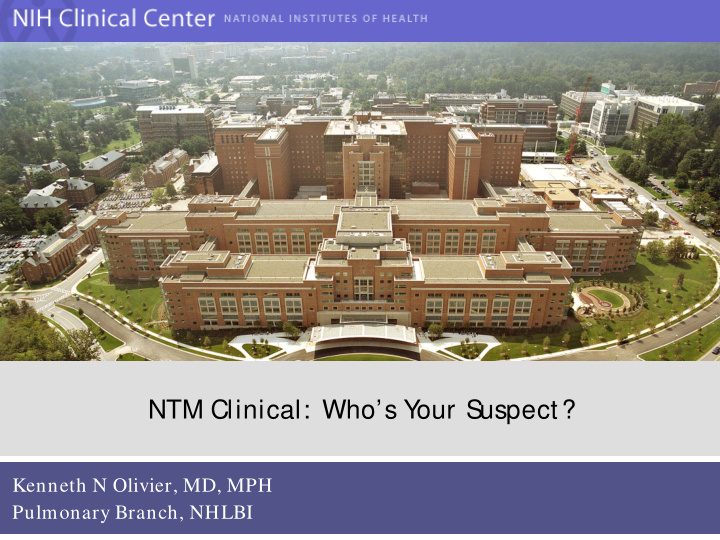



NTM Clinical: Who’s Y our S uspect? Kenneth N Olivier, MD, MPH Pulmonary Branch, NHLBI
Diagnostics and care:NTM • Current diagnostic techniques • Conflict of Interest ▫ None and future techniques in diagnostics • Non FDA Approved Drugs • Importance of strain typing ▫ None and drug sensitivity testing • Current standards of care and guidelines update
S usceptibility to NTM Pulmonary Disease Impaired local defenses Bronchiectasis, emphysema, Clinical history, chest imaging, pulmonary function pneumoconiosis, previous cavitary tests tuberculosis, silicosis, COPD Alpha-1 antitrypsin deficiency A1AT phenotype, level, genotyping Cystic fibrosis Sweat chloride test, CFTR genotyping Cardinal clinical features, measurement of nasal Primary ciliary dyskinesia nitric oxide, ciliary beat frequency, EM structure, genotyping (40+ genes) Impaired systemic immunity Total IgE, cardinal clinical features & family history, STAT3 deficiency STAT3 genotyping Immunosuppressant use Tumor necrosis factor- α blockers, Drug history, post-transplant steroids, tacrolimus Clinical history with exclusion of the above Lady Windermere syndrome susceptible factors, special body morphotypes Adapted from Wu. Lancet Infect Dis 2015
ATS / IDS A Pulmonary Dx Criteria • Clinical (all 3) ▫ Symptoms – cough most common ▫ Radiographic – cavities, bronchiectasis, nodules ▫ Exclusion of other diagnoses ▫ And … • Microbiologic (any of these) ▫ 2 positive sputum specimens ▫ 1 bronchial wash/ lavage ▫ Appropriate biopsy histopath & (+) resp culture Griffith. Am J Respir Crit Care Med 2007
The Voice of the Patient • 3 symptoms with most impact on daily life ▫ Coughing (including coughing up blood, phlegm or mucus) Triggers Changes in weather Talking Sprays and fumes Eating Sleeping position (e.g., lying down flat) Laughing Physical exertion Dust Air conditioning Mold ▫ Fatigue From feeling “tired to your core,” to “walking through molasses” Often had to “allocate” their energy to manage fatigue “My day is based on personal energy. I plan out what I am going to do based on how I feel.” ▫ Shortness of breath Often requires pacing themselves to avoid feeling winded Triggers: scents, walking, talking, physical activity that causes exertion U.S. FDA’s Patient-Focused Drug Development Initiative, Oct 2015
“ Classic” NTM Lung Disease • Male smoker • Cavitary, lots of bugs • Difficult to treat • Pathogenesis ▫ Structural disease ▫ Disrupted barriers ▫ Poor clearance ▫ Opportunistic
• Nodular bronchiectasis • No obvious predisposition ▫ Postmenopausal women ▫ Nonsmokers ▫ Chronic cough Reich. Chest 1992
Nontuberculous Mycobacteria • Ubiquitous environmental organisms ▫ Water including potable, soil • >180 species ▫ M. avium complex ▫ M. abscessus group ▫ M. kansasii ▫ M. m alm oense ▫ M. xenopi • Clinical ▫ Lung (85%) ▫ Skin, soft tissues ▫ Disseminated
Microbiology • Expectorated sputum ▫ Generally preferable to bronchoscopy ▫ Ideally, for diagnosis 3 early morning specimens on different days • Induced sputum ▫ Can be done safely and effectively using same hypertonic saline and oscillatory devices we prescribe for management of bronchiectasis • Send-in sputum from home collection ▫ Can be refrigerated & sent by overnight courier without compromise in recovery of mycobacteria ▫ Site logistics may not allow for this option
Microbiology • Possible indications for bronchoscopy ▫ Inability to collect adequate sputum specimens ▫ To exclude other diagnoses • Bronchoscopic or surgical lung biopsy ▫ Indications Exclude other diagnoses Rarely to assess significance of positive culture ▫ Very important that bronchoscopist/ surgeon sends specimen (not in formalin) for culture
Future Diagnostics • Direct detection, rapid antimicrobial resistance tests ▫ X-pert MTB/ Rif – 2hr detection of MTB and rifampin resistance mutations • Blood-based testing ▫ Immune response indicators ▫ Secreted mycobacterial antigens • Limitations ▫ Sensitivity/ specificity ▫ Ability to distinguish between mycobacterial species ▫ Ability to inform on antimicrobial susceptibility Liu. PNAS 2017
Importance of S train Typing & AS T • Patients followed over time acquire multiple species, subspecies, strains of NTM • Culture/ current species ID may miss change in predominant species/ strains 5’ end GPL locus, M. a b scessus genom e • Different species/ strains may have different susceptibilities or strains may acquire mutations over time that change virulence, susceptibility • Can affect determination of relapse vs reinfection Park. J Clin Microbiol 2015 Daniel-Wayman. (under review 2018) • Important in interpretation of clinical trial results Boyle. Ann Am Thorac Soc 2016 Olivier. Am J Resp Crit Care Med 2017
Laboratory of Chronic Airway Infection Sandi MacDonald, RN Kevin Fennelly, MD, MPH Kendra Bates, MS, MBA Research Nurse Senior Research Physician Branch Administrator Veronica Chavez Val Robinson, RN Dan Goldstein, PA-C Patient Care Coordinator Research Nurse Physician Assistant Joas Da Sliva, PhD Rose May, CRNP Kristijan Bogdanovski, BS Post-doc Fellow Nurse Practitioner Post-bac IRTA Fellow
Recommend
More recommend